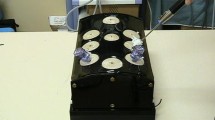Abstract
Background
During the course of certain laparoscopic procedures, a surgeon may encounter circumstances where the camera and working instruments are not aligned along the same axis. When the alignment is off by 180°, the laparoscope is pointed directly at the surgeon and a mirror image of the operative field is created. Under reverse alignment conditions, surgeons often become disoriented and task performance may be degraded. The aim of this study is to measure the degree to which reverse alignment conditions impair the performance of operators of varying laparoscopic surgical skill and experience.
Methods
Nineteen general surgery residents and 3 attending surgeons were tested in a video trainer. A task designed to simulate tack placement during laparoscopic ventral hernia repair was created. Time required to successfully complete this task in both forward and reverse alignment conditions was measured for all participants. For this study, the impact of visual-spatial discordances of angles other than 180° on task performance was not assessed. Data regarding prior laparoscopic case volume and MISTELS scores were collected for each resident.
Results
Significant and strong correlations were observed between resident experience and individual MISTELS scores. No significant correlation was found between reverse image times and any other surrogate measure of experience or skill for the residents. All study participants required a significantly longer period of time to complete the simulated tack task in reverse alignment compared to forward alignment conditions. Attendings required 65% more time and resident times increased by 470%. Attendings completed the task significantly faster than residents in reverse alignment conditions.
Conclusions
Reverse-alignment surgical skills can be improved with experience, but may require a volume of cases exceeding that encountered in residency training. Reverse image skills are not derivative from surgical skills developed in a video trainer with forward orientation.
Similar content being viewed by others
References
Bock O (1992) Adaptation of aimed arm movements to sensorimotor discordance: evidence of direction independent gain control. Behav Brain Res 51: 41–50
Bock O, Schneider S, Bloomberg J (2001) Conditions for interference versus facilitation during sequential sensorimotor adaptation. Exp Brain Res 138: 359–365
Conrad J, Shah AH, Divino CM, Schluender B, Gurland B, Shlasko E, Szold A (2006) The role of mental rotation and memory scanning on the performance of laparoscopic skills. Surg Endosc 20: 504–510
Cresswell AB, Macmillan AM, Hanna GB, Cuschieri A (1999) Methods for improving performance under reverse-alignment conditions during endoscopic surgery. Surg Endosc 13: 591–594
Derossis AM, Fried GM, Abrahamowicz M, Sigman HH, Barkun JS, Meakins JL (1998) Development of a model for training and evaluation of laparoscopic skills. Am J Surg 175: 482–487
Emam TA, Hanna G, Cuschieri A (2002) Ergonomic principles of task alignment, visual display, and direction of execution of laparoscopic bowel suturing. Surg Endosc 16: 267–271
Fraser SA, Klassen DR, Feldman LS, Ghitulescu GA, Stanbridge D, Fried GM (2003) Evaluating laparoscopic skills: setting the pass/fail score for the MISTELS system. Surg Endosc 17: 964–967
Georgopoulos A, Pellizer G (1995) The mental and the neural: psychological and neural studies of mental rotation and memory scanning. Neuropsychologia 33: 1531–1547
Pierret A, Peronnet F (1994) Mental rotation and mirror-image discrimination. Percept Mot Skills 78: 515–524
Pine ZM, Krakauer JW, Gordon J, Ghez C (1996) Learning of scaling factors and reference axes for reaching movements. Neuroreport 7: 2357–2361
Wohlschlager A (2001) Mental object rotation and the planning of hand movements. Percept Psychophys 63: 709–718
Author information
Authors and Affiliations
Corresponding author
Rights and permissions
About this article
Cite this article
Gould, J.C., Frydman, J. Reverse-alignment surgical skills assessment. Surg Endosc 21, 669–671 (2007). https://doi.org/10.1007/s00464-006-9135-2
Received:
Revised:
Accepted:
Published:
Issue Date:
DOI: https://doi.org/10.1007/s00464-006-9135-2




